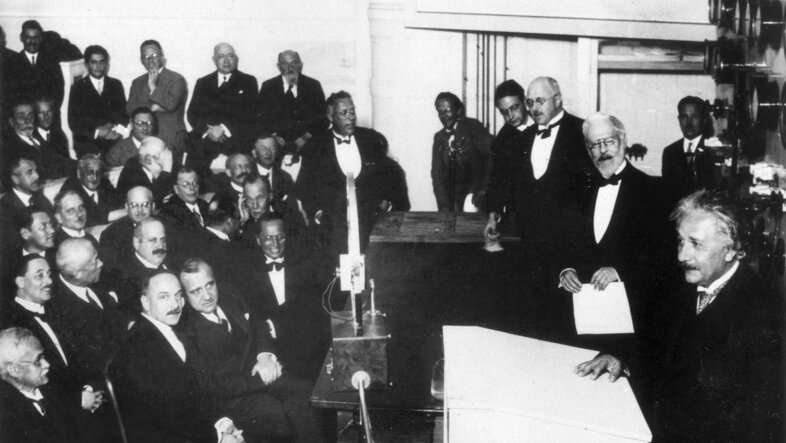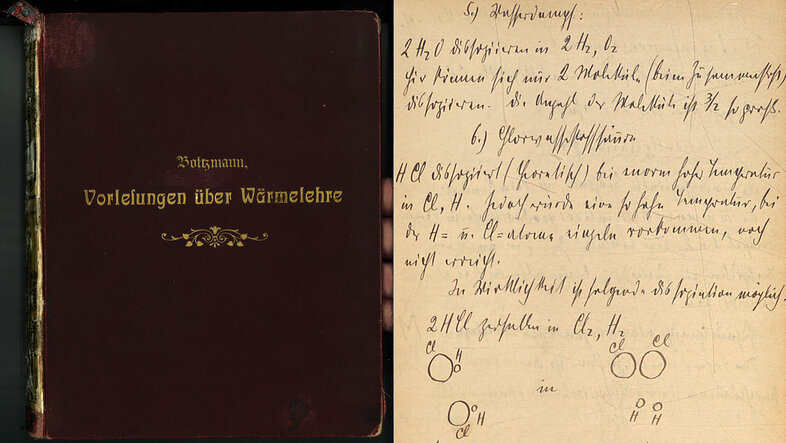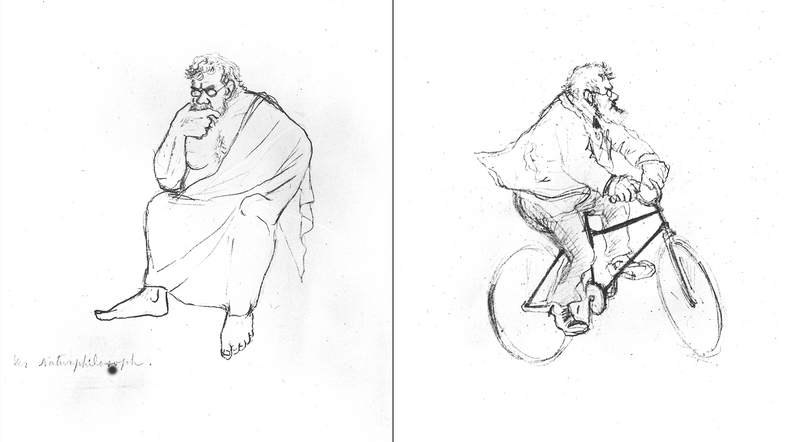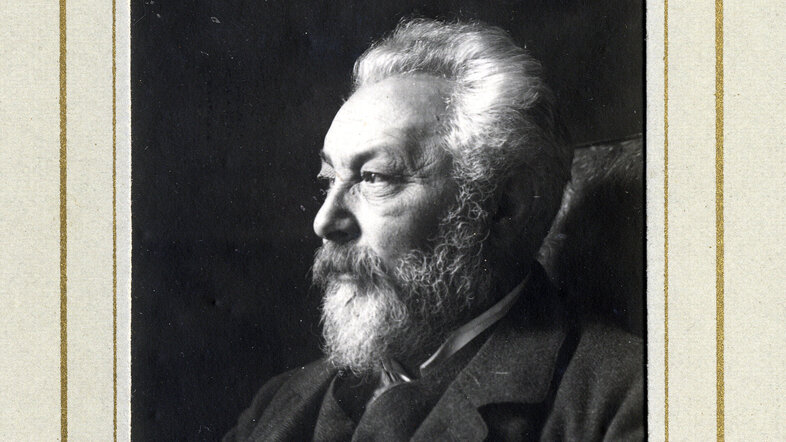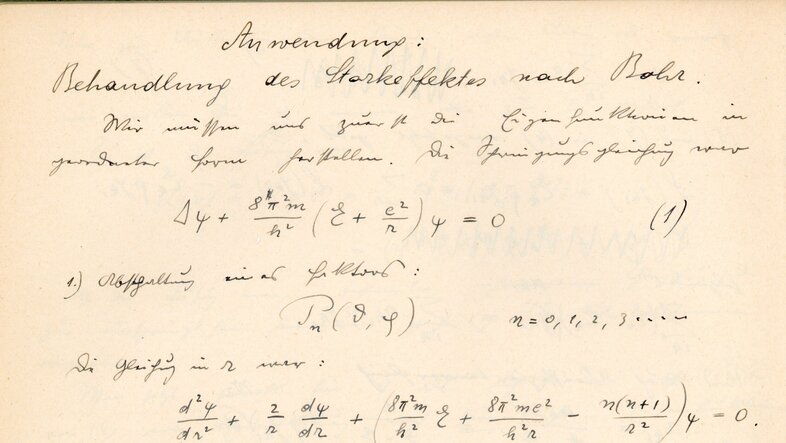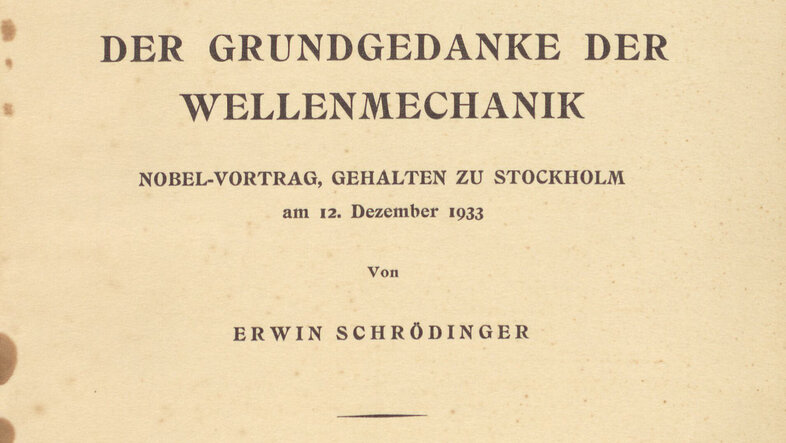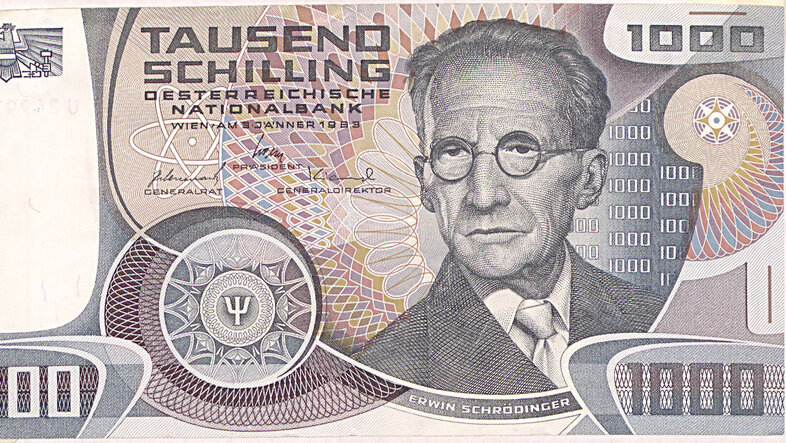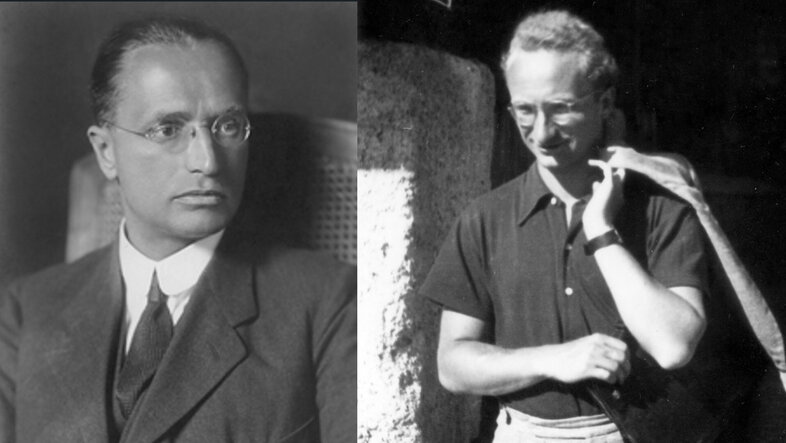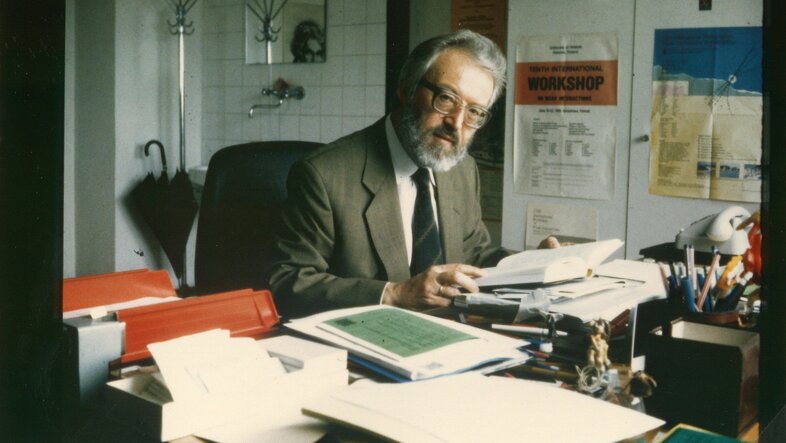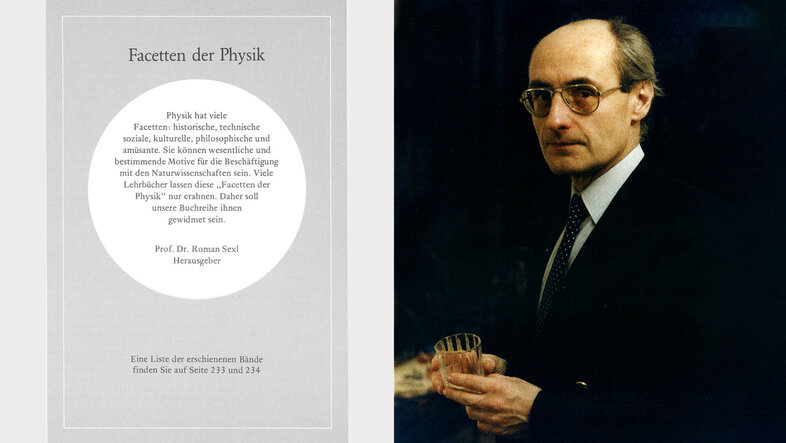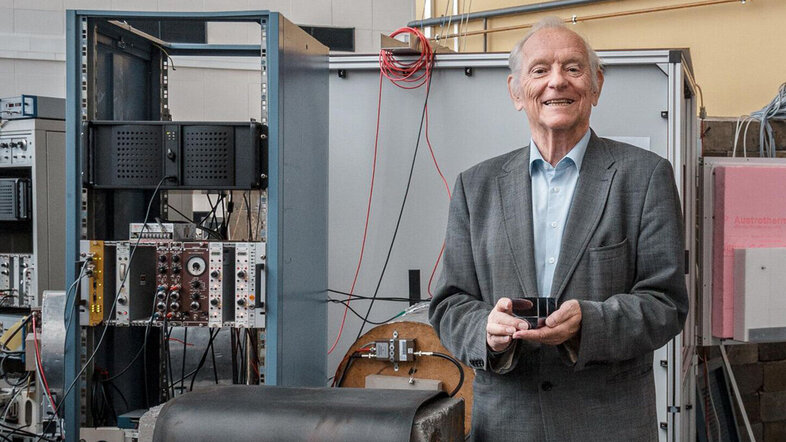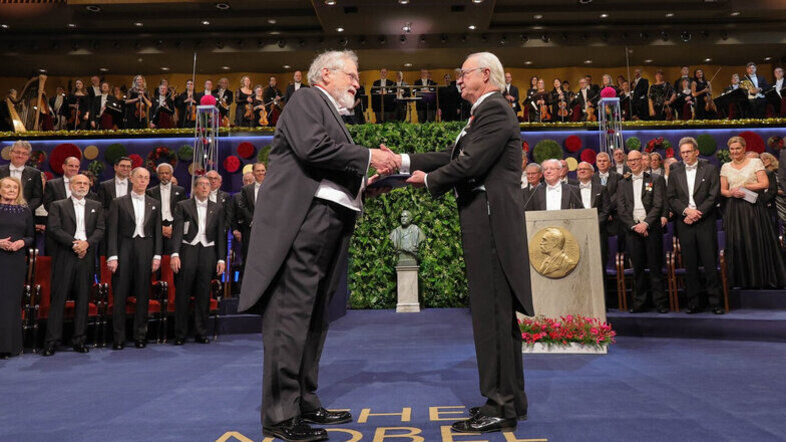The entanglement of physics and philosophy
Once invented to describe the radiation of black bodies and the movement of electrons around the atomic nucleus, quantum physics is an indispensable part of today’s everyday life. It is behind the semiconductor chips in our computers, it enables satellite navigation and lasers, and can be used for imaging techniques in medicine such as MRI scans – in short, without quantum physics, our information age would be simply unthinkable.
In principle, quantum research allows us to describe our world more accurately than ever before. At crucial points over the last 100 years, researchers from the University of Vienna have crucially contributed to the success story of quantum physics. However, the history of quantum research at the University does not commence with technicalities, but instead, as a kind of prologue, with a philosophical disagreement.
A productive conflict
It was the famous physicists Ernst Mach and Ludwig Boltzmann who were involved in an intense philosophical debate at the turn of the century in Vienna. The topic was the role of probabilities, which Boltzmann had introduced into physics. "Even today, many people still believe – as they did then – that probabilities arise because we do not know everything about a system and that we could get rid of them if we had access to an underlying reality," explains physicist Flavio Del Santo.
Del Santo conducts research at the University of Vienna on fundamental and philosophical questions within the field of quantum physics. He has also published work on the history of quantum research in Vienna and knows the sticking points of the debate between Mach and Boltzmann. Unlike Mach, Boltzmann was convinced that probabilities are not caused by ignorance but instead are fundamental in themselves. “Boltzmann assumed that statistical laws form the basis of our physics.”
Interestingly, this dispute has still not been settled. In the world of physics there continue to be ongoing debates about the interpretation of quantum physics, which itself includes mathematical objects whose reality is still contested among physicists and philosophers. What, for example, do states of superposition mean, where particles appear to go in several directions at the same time? Another mathematical trompe l’oeil? Or is the world fundamentally undetermined?
As Mach and Boltzmann noted, our scientific theories may contain such philosophical problems even if we know very well how to apply them. This is true for statistical physics, but all the more so for quantum research. Thus, the debate between these two physicists set the course for quantum physics in Vienna, which is still largely devoted to conceptual questions.
The Franz Exner Circle: A breeding ground for bright minds
"Boltzmann's views were extremely influential in Vienna,” says Del Santo, "and were taken up by the physicist Franz Serafin Exner Jr., who played a key role in the development of physics in Vienna." Exner supported young physicists and gathered many of them around him – amongst them the theorists Hans Thirring and Fritz Hasenöhrl as well as the pioneer of nuclear fission Lise Meitner and the two later Nobel Prize laureates Victor Franz Hess and Erwin Schrödinger.
Exner and his followers would spend much of their time discussing conceptual issues from the world of physics. "As Rector of the University of Vienna, Exner even spoke during a public lecture about absolute coincidence being the basis of physics – even before quantum mechanics emerged," Del Santo explains. "For Exner and his group, the Mach-Boltzmann debate became the basis of their intellectual activities." Ernst Mach also influenced Vienna's intellectual scene, having received a professorship at the University of Vienna for "Philosophy, in Particular the History of Inductive Sciences" – the world's first professorship in Philosophy of Science.
Schrödinger, meanwhile, moved away from Exner and his circle. After his studies – and after the First World War – he relocated to Berlin in the 1920s. In the meantime, Werner Heisenberg was, for the first time, able to describe the already-known quantum effects in a unified manner in 1925. It is this theory construct, known as matrix mechanics, whose centenary we celebrate this year with the International Year of Quantum Science and Technology.
Heyday of physics and philosophy
Hot on the heels of Heisenberg, Schrödinger also came up with his formulation of quantum physics: wave mechanics. In 1926, the world-famous Schrödinger equation was published, which describes how probability density waves assigned to each quantum system behave in different situations. The amplitude of these waves can be used to specify probabilities for the behaviour of a quantum system.
Ultimately, Schrödinger was able to show that wave mechanics and matrix mechanics can be converted one into the other – very much to the displeasure of Heisenberg, who insisted that his matrices were indeterminate and claimed that Schrödinger's waves were the source of misleading ideas. What is for sure is that Heisenberg and Schrödinger both received the Nobel Prize for their achievements. "And although Schrödinger soaked up the Viennese intellectual spirit of the age during his time studying there, he did not contribute to any new physics at the University of Vienna after his doctorate," Del Santo notes.
While Schrödinger enjoyed his fame in Germany, another circle of scholars met in the halls of Vienna’s Faculty of Physics in the 1930s. The Vienna Circle, strongly influenced by Ernst Mach, not only maintained close personal connections to the Faculty of Physics, but regarded the discipline as a fundamental model for scientific work in general. "The Vienna Circle founded logical positivism, that is, the idea that science can be reconstructed strictly logically from observations," explains Del Santo.
While the Vienna Circle had no direct connections to quantum physics, researchers in contact with the field such as the Viennese philosopher Karl Popper were concerned early with the implications of quantum research for our world view. "In 1934, Popper worked on problems of quantum physics and even proposed physical experiments in the 1980s in an attempt to explain entanglement,” says Del Santo.
Cultural demise
However, the flourishing intellectual scene that had prevailed in Vienna since the turn of the century came to an abrupt and violent end. The late 1930s saw the spread of rabid anti-Semitism and German nationalism, including at the University of Vienna, paving the way for the ‘Anschluss’ between Austria and Nazi Germany in 1938. Cheered on by the masses, the arrival of National Socialism in Austria marked the end of Vienna’s intellectual heyday.
"Growing up in an environment without hyperspecialisations, with people who could master both abstract calculations and philosophical discussions – this extraordinary environment disappeared under fascism," says Del Santo. “After the mass killings and destruction of the war, this cultural damage was among the most serious of any left behind in Europe.”
The Nazis fired around half of the Viennese physicists for ethnic or political reasons, and about 40 percent were forced to emigrate. Erwin Schrödinger, who moved to the University of Graz in 1936, was also dismissed in summer 1938 because of his political convictions and left Austria in the autumn of that year. He spent the war in exile in Ireland and would not return to his home country until 1956.
Difficult post-war years
It fell to Hans Thirring to put together the pieces of what was left of Vienna’s physics scene after the end of the war. Soon, however, the professor of theoretical physics turned his attention to political issues, becoming a member of the Socialist Party in the Federal Council and a pioneer of the anti-nuclear movement. This meant that there was no teaching of quantum physics at the University of Vienna until 1959. Even Schrödinger, upon his return, gave only one lecture on this subject.
Ultimately it was Thirring's son, Walter, who reinvigorated quantum physics in Vienna. "The first thing Walter Thirring did was to go on a tour visiting the most important physicists of his time, for example to Dublin to see Schrödinger, to Zurich to see Wolfgang Pauli and even to Princeton to meet Einstein," Del Santo says. “He came back to Vienna as a star and took over the dean’s office of the Faculty of Physics from his father in 1959 – a real scandal at the time.”
It was Walter Thirring, too, who finally reintroduced the teaching of quantum physics, contributed to quantum field theory and later led Austria to CERN, where he was in charge of the theory department in the 1960s. However, with Thirring away in Geneva, there was a danger that quantum physics in Vienna could once again slip into insignificance. Fortunately, Herbert Pietschmann, who graduated with Thirring in 1960, took up the mantle. Moreover, Pietschmann showed a renewed interest in fundamental questions.
In the Philosophical-Scientific Working Group, which Pietschmann operated with the philosopher Gerhard Schwarz, we again find the tradition of philosophical exchange that was still largely dormant at that time. The working group became a source of inspiration for many physicists, not least because of the regular participation of physicist Roman Sexl.
Sexl was not only an important physicist, but also a brilliant communicator. His book series Facets of Physics restored the dialogue between physics, philosophy, but also art and culture, which had been so natural during the pre-war period. For Del Santo, this marks the beginning of a true renaissance.
Rise of quantum foundations
As the working group formed, two young men crucial for the rise of quantum research in Vienna and Austria as a whole began their physics studies at the University of Vienna: Reinhold Bertlmann and Anton Zeilinger. Bertlmann, a specialist in theory, earned his doctorate under the supervision of Herbert Pietschmann in 1974 and shortly afterwards moved on to CERN, where he worked with a man who is of outstanding importance for modern quantum physics: John Stewart Bell.
At that time, Bell was working as a particle physicist, and it was in this discipline that he started collaborating with his work colleague – and soon-to-be good friend – Bertlmann. But Bell held a secret passion for quantum foundations, a field in which he would go on to contribute the famous Bell’s Theorem. This theorem comprises statistical laws that must comply with certain models with which physicists aimed to explain the non-local behaviour of entangled quantum systems.
„Shut up and calculate“
Bell played down this side of his work – after all, at the time there was the dogma “shut up and calculate” when it came to physics, meaning physicists should deal in real-world calculations instead of wasting their time on questions such as the nature of entanglement, which were dismissed as nothing more than philosophical parlour games. But Pietschmann and Sexl broke with this dogma, creating space at the University of Vienna for fundamental questions to be met with openness. It was via Bertlmann that John Bell first came to Vienna for a lecture series in the 1980s and later to a conference at the University of Vienna, where the quantum foundations were finally offered a stage. Joining Bell on the podium back then was a young man by the name of Anton Zeilinger.
In 1971, Zeilinger had completed his dissertation under the supervision of Helmut Rauch. Rauch, who gained his doctorate under the supervision of Gustav Ortner at the Atomic Institute of the Vienna University of Technology in the mid-1960s, would go on to play a key role in quantum physics in Vienna. A colleague of Rauch and previously Ortner, Otto Hittmair, who worked as a postdoctoral researcher under Schrödinger in Dublin and at MIT, prepared the ground for the pioneering role of the Vienna University of Technology in experimental quantum research. It was in part from Hittmair's writings that Anton Zeilinger learned quantum physics.
Rauch, professor at the Vienna University of Technology from 1972, developed novel neutron interferometres made of silicon crystals, which can be used to study the ripple nature of neutrons, the uncharged building blocks of the nuclear core. In Rauch's group Zeilinger developed his interest in quantum foundations. In particular Rauch's ability to be inspired by conceptual questions about experiments paved the way for the further course of quantum research in Vienna. It was also Rauch who was approached by Karl Popper with ideas for new experiments.
"The outstanding openness of the Vienna University of Technology towards these topics at the time is shown by the fact that it put a lot of energy into research such as neutron interference," says Del Santo. Zeilinger also conducted experiments on the wave behaviour of neutrons at the research reactor of the Atomic Institute. When he presented his fundamental findings at a conference in Italy in 1976, it was the first time that Zeilinger came into contact with terms such as 'entanglement' and 'Bell’s Theorem'. They would go on to shape his research.
Vienna – a hub of quantum research
Starting in the 1980s, Zeilinger conceived the experiments that would eventually make him famous. His group was involved in pioneering work with entangled light particles that not only addressed fundamental questions about the nature of this phenomenon, but also paved the way for technological applications. For example, Zeilinger's joint work with the US physicists Michael Horne and Daniel Greenberger on non-locality and his attempts to teleport quantum states gained widespread recognition.
Zeilinger, then a professor at the University of Innsbruck, gave his interest in conceptual issues the form of a seminar on quantum foundations that he held together with Bertlmann at the University of Vienna in the 1990s. "This seminar had a formative effect on many people," recalls Del Santo, who later was a participant himself. “Without this seminar, which aroused my interest in the topic, I would not be doing research on quantum foundations today.”
Following Zeilinger's move to the University of Vienna in 1999, Vienna once and for all established itself as a key hub of quantum research. In theory and experimentation, the Faculty of Physics is now internationally renowned for research open to application with a focus on fundamental aspects of quantum physics. "What makes Vienna extraordinary is the ability to take problems that are perceived as a waste of time elsewhere and treat them as essential questions,” explains Del Santo. This attitude was also honoured in 2022 with the Nobel Prize in Physics for Anton Zeilinger, which he received together with John Clauser and Alain Aspect.
Today, the group of Quantum Optics, Quantum Nanophysics and Quantum Information at the University of Vienna has six experimental groups and five theory groups, which have together released more than 140 specialist publications since Zeilinger's Nobel Prize alone. The scientists deal with a wide range of topics ranging from matter wave interferometry, quantum multiple particle systems, to interception-proof communication and quantum computers, to the behaviour of gravity in the quantum world.
The quantum group has acquired several ERC grants, while its researchers are regularly amongst the most cited scientists in the world and have received multiple awards. In addition, promising start-ups have already emerged from the quantum group. However, since quantum physics also plays a key role in other research groups and faculties, these figures and topics merely give a small insight into quantum research at the University of Vienna and are no more than a brief sample of the work that goes on at the University.
Together with the TU Wien, the Institute for Quantum Optics and Quantum Information (IQOQI) of the Austrian Academy of Sciences with locations in Vienna and Innsbruck and the Institute for Science and Technology (ISTA) in Klosterneuburg, the quantum groups of the University of Vienna form the research consortium Vienna Centre for Science and Technology (VCQ). "Vienna is home to one of the largest quantum communities in the world," says Del Santo. May this remain so – here’s to the next hundred years!
- Research group “Quantum Optics, Quantum Nanophysics and Quantum Information” at the University of Vienna
- Vienna Center for Science and Technology (VCQ)
- Semester question 2025: Quantum research at the University of Vienna
- Youtube Playlist: Quantum basics made simple
- Events at University of Vienna in the Quantum Year 2025
